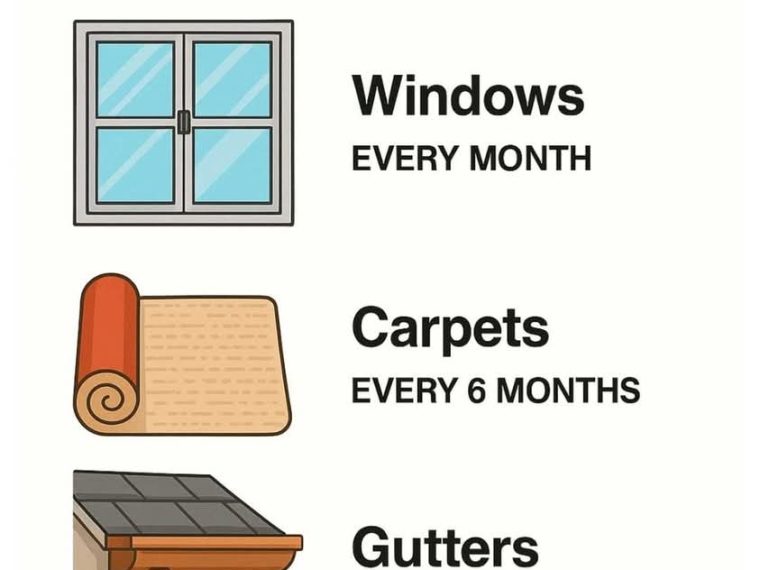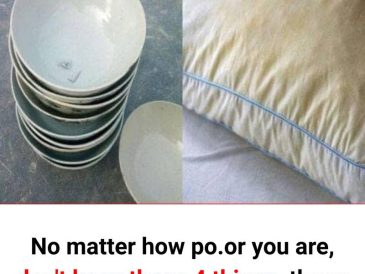Cleaning is an essential part of maintaining a healthy and pleasant living environment, yet many of us often overlook or misjudge how frequently certain items should be cleaned. While some areas of the home are obvious candidates for regular cleaning, others might not be as apparent, leading to a buildup of dirt, germs, and allergens that can affect our health and comfort.
In this article, we will explore the recommended cleaning frequencies for various household items and areas. By following these guidelines, you can ensure that your home remains a clean and inviting space for you and your family. From windows to mattresses, each section will provide detailed insights into why and how often these items should be cleaned.
1. Windows: Every Month
Windows are often the first thing people notice about a house, both from the inside and outside. Cleaning them every month ensures that they remain free of dust, smudges, and streaks, allowing natural light to brighten your home. Use a mixture of vinegar and water or a commercial glass cleaner, and wipe with a microfiber cloth for a streak-free finish.
Regular window cleaning also helps to prevent the buildup of grime that can etch into the glass over time, potentially causing permanent damage. Pay special attention to window sills and tracks, as these areas can accumulate dirt and debris that may impede the window’s functionality.
2. Carpets: Every 6 Months
Carpets can harbor a multitude of allergens, dust mites, and bacteria, making it crucial to clean them every six months. Regular vacuuming is essential, but a deep clean using a steam cleaner or professional service will remove embedded dirt and refresh the fibers.
For high-traffic areas or homes with pets, more frequent cleaning may be necessary. Spot cleaning spills and stains immediately can also help maintain the carpet’s appearance and prevent long-term damage.
3. Gutters: Every Year
Gutters play a vital role in directing rainwater away from your home, preventing water damage and foundation issues. Cleaning them at least once a year, preferably in the fall after leaves have fallen, ensures they remain clear of debris that can cause blockages.
Use a sturdy ladder and gloves to remove leaves, twigs, and other debris. Consider installing gutter guards to reduce the frequency of cleaning and protect against clogs.
4. Air Filters: Every 3 Months
Air filters in your HVAC system should be replaced every three months to maintain optimal air quality and system efficiency. Dirty filters can restrict airflow, forcing your system to work harder and increasing energy costs.
In homes with pets or allergy sufferers, more frequent replacement may be necessary. Regularly checking and replacing air filters can also prolong the lifespan of your HVAC system.
5. Kitchen Sink: Daily
The kitchen sink is a hotspot for bacteria due to its constant exposure to food particles and moisture. Cleaning it daily with a disinfectant cleaner or a mixture of baking soda and vinegar can prevent the growth of harmful germs.
Pay attention to the faucet and handles, as these areas are often touched with dirty hands. Regular cleaning will keep your sink sparkling and hygienic.
6. Refrigerator: Every 3 Months
Cleaning your refrigerator every three months helps to prevent odors and the growth of mold and bacteria. Start by removing all items and wiping down shelves and drawers with a mixture of warm water and mild dish soap.
Check expiration dates and discard any expired or spoiled food. Regular cleaning also provides an opportunity to reorganize and ensure that your refrigerator is running efficiently.
7. Bathroom Tiles: Weekly
Bathroom tiles are prone to mold and mildew due to the damp environment. Cleaning them weekly with a mild bleach solution or a specialized tile cleaner can prevent buildup and keep your bathroom looking fresh.
Pay special attention to grout lines, as these can harbor dirt and bacteria. A toothbrush or grout brush can be used to scrub these areas effectively.
8. Bed Linens: Weekly
Washing bed linens weekly is essential for removing sweat, body oils, and allergens that accumulate over time. Use hot water to kill dust mites and bacteria, and choose a detergent that suits your skin sensitivity.
Regularly washing pillowcases and sheets can also improve sleep quality by providing a clean and comfortable sleeping environment.
9. Washing Machine: Monthly
A washing machine can harbor mold and mildew, especially in the detergent drawer and rubber seal. Cleaning it monthly with a washing machine cleaner or a mixture of vinegar and baking soda can prevent odors and maintain efficiency.
Run an empty cycle with hot water and the cleaning solution, and wipe down the exterior and drum to remove any residue.
10. Oven: Every 3 Months
Ovens can accumulate grease and food residue, which can affect cooking performance and create unpleasant odors. Cleaning your oven every three months, or more frequently if heavily used, ensures it remains in good working order.
Use a commercial oven cleaner or a homemade paste of baking soda and water. Apply the cleaner, let it sit, and then scrub away grime with a non-abrasive pad.
11. Curtains: Every 3 to 6 Months
Curtains can collect dust, allergens, and odors, making it important to clean them every three to six months. Check the care label for washing instructions, as some curtains may be machine washable while others require dry cleaning.
Regular cleaning can also help to preserve the fabric’s color and texture, ensuring your curtains remain a beautiful addition to your home decor.
12. Mattresses: Every 6 Months
Mattresses should be cleaned every six months to remove dust mites, dead skin cells, and allergens. Vacuum the surface with an upholstery attachment, and spot clean any stains with a mild detergent.
Consider using a mattress protector to reduce the need for frequent cleaning and to extend the lifespan of your mattress. Rotating or flipping your mattress regularly can also help to maintain its shape and comfort.





